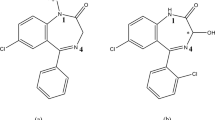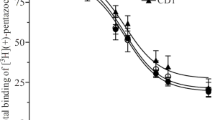Abstract
The biochemical and pharmacological properties of nuclear [3H]flunitrazepam in brain tissues were studied. Nuclear [3Hflunitrazepam binding is saturable for both central and peripheral binding sites. Inosine and hypoxanthine displace nuclear [3H]flunitrazepam binding with greater potency than the membrane [3H]flunitrazepam binding. Triiodothyronine (T3) increases the maximum number of binding sites (Bmax) of nuclear [3H]flunitrazepam binding in vitro while thyroxine (T4) does not have any effect. Diazepam reduces the affinity of nuclear125I-T3 binding in vitro, while the Bmax is not affected significantly. Mild digestion of chromatin, using micrococcal nuclease, reveals that a major portion of nuclear [3H]flunitrazepam binding sites are located on chromatin. These data suggest a functional role for nuclear benzodiazepine binding and a possible modulatory effect of benzodiazepines on T3 binding with its nuclear receptors.
Similar content being viewed by others
References
Squires, R. F., and Braestrup, C. 1977. Benzodiazepine receptors in rat brain. Nature 266:732–734.
Braestrup, C., and Squires, R. F. 1977. Specific benzodiazepine receptors in rat brain characterized by high-affinity [3H]diazepam binding. Proc. Natl. Acad. Sci. USA 74:3805–3809.
Braestrup, C., Albrechtsen, R., and Squires, R. F. 1977. High densities of benzodiazepine receptors in human cortical areas. Nature 269:702–704.
Mohler, H., and Okada, T. 1977. Properties of [3H]diazepam binding to benzodiazepine receptors in rat cerebral cortex. Life Sci. 20:2101–2110.
Mohler, H., and Okada, T. 1978. Biochemical identification of the site of action of benzodiazepines in human brain by [3H]diazepam binding. Life Sci. 22:985–996.
Speth, R. C., Wastek, G. J., Johnson, P. C., and Yamamura, H. I. 1978. Benzodiazepine binding in human brain: Characterization using [3H]flunitrazepam, Life Sci. 22:859–866.
Olsen, R. W. 1981. GABA-benzodiazepine-barbiturate receptor interactions. J. Neurochem. 37:1–13.
Placheta, P., and Karobath, M. 1979. Regional distribution of Na+-independent GABA and benzodiazepine binding sites in rat CNA. Brain Res. 178:580–583.
Schoemaker, H., Bliss, M., and Yamamura, H. I. 1981. Specific high-affinity saturable binding of [3H]Ro5-4864 to benzodiazepine binding sites in the rat cerebral cortex. Eur. J. Pharmacol. 71:173–175.
Skolnick, P., Marangos, P. J., Goodwin, F. K., Edwards, M., and Paul, S. 1978. Identification of inosine and hypoxanthine as endogenous inhibitors of [3H]diazepam binding in the central nervous system. Life Sci. 23:1473–1480.
Asano, T., and Spector, S. 1979. Identification of inosine and hypoxanthine as endogenous ligands for the brain benzodiazepine-binding sites. Proc. Natl. Acad. Sci. USA 76:977–981.
Marangos, P. J., Paul, S. M., Parma, A. M., Goodwind, F. K., Syapin, P., and Skolnick, P. 1979. Purinergic inhibition of diazepam binding to rat brain (in vitro). Life Sci. 24:851–858.
Slater, P., and Longman, D. A. 1979. Effects of diazepam and muscimol on GABA-mediated neurotransmission: Interaction with inosine and nicotinamide. Life Sci. 25:1963–1967.
Skerritt, J. H., Chow, S. C., Johnston, G. A. R., and Davies, L. P. 1982. Purines interact with “central” but not “peripheral” benzodiazepine binding sites. Neursci. Lett. 34:63–68.
Nagy, A., and Lajtha, A. 1983. Thyroid hormones and derivatives inhibit flunitrazepam binding. J. Neurochem. 40:414–417.
Medina, J. H., and De Robertis, E. 1985. Benzodiazepine receptor and thyroid hormones: In vivo and in vitro modulation. J. Neurochem. 44:1340–1344.
Bosmann, H. B., Penney, D. P., Case, K. R., and Averill, K. 1980. Diazepam receptor: Specific nuclear binding of [3H]flunitrazepam an Proc. Natl. Acad. Sci. USA 77:1195–1198.
Perez, C., Cruciani, R., Rubio, M. C., and Stefano, F. J. E. 1985. Benzodiazepine binding sites in rat submaxillary gland: Absence of markers of GABA system. Comp. Biochem. Physiol. 82C:451–456.
Matsokis, N., and Dalezios, Y. 1986. Comparative aspects of cerebellar [3H]flunitrazepam and [3H]-GABA binding. Gen. Pharmac. 17:689–693.
Wu, P. H., Phillis, J. W., and Bender, A. S. 1981. Do benzodiazepines bind at adenosine uptake sites in CNS? Life Sci. 28:1023–1031.
Hammond, J. R., Paterson, A. R. P., and Clanachan, A. S. 1981. Benzodiazepine inhibition of site-specific binding of nitrobenzylthioinosine, an inhibitor of adenosine transport. Life Sci. 29:2207–2214.
Eberhardt, N. L., Valcana, T., and Timiras, P. S. 1978. Triiodothyronine nuclear receptors: An in vitro comparison of the binding of triiodothyronine to nuclei of adult rat liver, cerebral hemisphere, and anterior pituitary. Endocrinology 102:556–561.
Popov, N., Pohle, W., Lossner, B., Schulzeck, S., Schmidt, S., Ott, T., and Matthies, H. 1973. Regional distribution of RNA and protein radioactivity in the rat brain after intraventricular application of labeled precursors. Acta Biol. Med. Germ. 31:51–62.
Lowry, O. H., Rosebrough, N. J., Farr, A. L., and Randall, R. J. 1951. Protein measurement with the folin phenol reagent. J. Biol. Chem. 193:265–275.
Burton, K. A. 1956. Study of the conditions and mechanism of the diphenylamine reaction for the colorimetric estimation of DNA. Biochem. J. 62:315–322.
Valcana, T. 1979. The role of triiodothyronine (T3) receptors in brain development. Pages 39–58,in Meisami, E., and Brazier, M. A. B. (eds.), Neural Growth and Differentiation, Raven Press, New York.
Anholt, R. R. H., Pedersen, P. L., DeSouza, E. B., and Snyder, S. H. 1986. The peripheral-type benzodiazepine receptor: localization to the mitochondrial outer membrane. J. Biol. Chem. 261:576–583.
Snyder, S. H., Verma, A., and Trifiletti, R. R. 1987. The peripheral-type benzodiazepine receptor: a protein of mitochondrial outer membranes utilizing porphyrins as endogenous ligands. FA-SEB J. 1:282–288.
Snyder, S. H., McEnery, M. W., and Verma, A. 1990. Molecular mechanisms of peripheral benzodiazepine receptors. Neurochem. Res. 15:119–123.
Antkiewicz-Michaluk, L., Guidotti, A., and Krueger, K. E. 1988. Molecular characterization and mitochondrial density of a recognition site for peripheral-type benzodiazepine ligands. Molec. Pharmacol. 34:272–278.
Mukhin, A. G., Papadopoulos, V., Costa, E., and Krueger, K. E. 1989. Mitochondrial benzodiazepine receptors regulate steroid biosynthesis. Biochemistry 86:9813–9816.
Papadopoulos, V., Mukhin, A. G., Costa, E., and Krueger, K. E. 1990. The peripheral-type benzodiazepine receptor is functionally linked to Leydig cell steroidogenesis. J. Biol. Chem. 265:3772–3779.
Phillis, J. W., Walter, G. A., and Simpson, R. E. 1991. Brain adenosine and transmitter amino acid release from the ischemic rat cerebral cortex: Effects of the adenosine deaminase inhibitor deoxycoformycin. J. Neurochem. 56:644–650.
Skolnick, P., and Paul, S. M. 1981. The mechanism(s) of action of benzodiazepines. Medicinal Res. Rev. 1:3–22.
Friedman, H., Abernethy, D. R., Greenblatt, D. J., and Shader, R. I. 1986. The pharmacokinetics of diazepam and desmethyldlazepam in rat brain and plasma. Psychopharmacol. 88:267–270.
Phillis, J. W., and O'Regan, M. H. 1988. The role of adenosinc in the central actions of the benzodiazepines. Prog. Neuro-Psychopharmacol. and Biol. Psychiat. 12:389–404.
Klotz, U. 1991. Occurence of “natural” benzodiazepines. Life Sci. 48:209–215.
Evans, R. M. 1988. The steroid and thyroid hormone receptor superfamily. Science 240:889–894.
Author information
Authors and Affiliations
Rights and permissions
About this article
Cite this article
Dalezios, Y., Matsokis, N. Nuclear benzodiazepine binding: Possible interaction with thyroid hormone receptors. Neurochem Res 18, 305–311 (1993). https://doi.org/10.1007/BF00969087
Accepted:
Issue Date:
DOI: https://doi.org/10.1007/BF00969087




